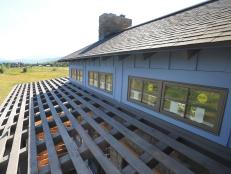Choosing Materials for Your Addition

Blending your new addition with the existing house means choosing new materials and finishes that match—or at least complement—what's already in the building. But that's not always easy. Here's what to think about as you choose nine key surfaces for your project:
Wood Flooring. Any good flooring contractor can identify and match the species of your old floor as well as the width of its strips—and he can come pretty close to matching any stain color that's on the old floor too. But the results are never quite identical because of slight differences in wood grain and stain. "As long as there's a break between the rooms, I wouldn't worry about the discrepancy," says Castle Rock, Colo., design-build contractor Dean Bennett. If on the other hand, the floors tie together in an open plan, you'll likely need to replace the old wood floors—or at least sand and refinish them with the new wood—to ensure a good match.
Tile. Your chances are pretty slim of finding an exact match for almost any tile in your house. Other than fairly recent installations of basic ceramic tile—such as 4x4s or subway tiles—it's very unlikely you'll see the exact same color at any retailer. If you're willing to throw significant money at the problem, send a sample to North Prairie Tileworks in Minneapolis, a company that specializes in custom reproductions, to see if they can make a match. Otherwise, assuming the surfaces are contiguous, you'll need to re-tile the whole area.
Roofing. "Because of the slowdown in the economy, roofing manufacturers have drastically scaled back the number of colors they're offering," says Curt Schultz, a Realtor-architect-builder in Pasadena, Calif. "So you may not be able to find a match for even fairly new roofing." If the addition roof isn't connected to the old one, you can get away with doing something different, whether it's a similar three-tab asphalt shingle in a slightly different color—or a completely dissimilar material, such as metal. Of course, if the roof is nearing the end of its life anyway, consider reroofing everything at the same time in the new shingles.
Siding. Wood clapboards and shingles are pretty easy to match, aside from some unusual fancy cuts—such as round, "fishscale" or diamond butt ends—that may need to be ordered from specialty houses, like Vintage Woodworks or Wolf Creek Cedar. Vinyl siding and stone are nearly impossible to match, so use a different material, such as stucco. Matching stucco or brick is more feasible, but not easy; make sure your mason is careful to replicate the texture of the stucco finish or to search out a similar color of brick.
Windows. Thanks to double paned glass—which means no exterior storms are required—your new windows won't look exactly like the old ones. Older, single pane glass windows require storms, second windows added to the outside of the main window as additional protection against drafts and severe weather. Still, you should do what you can to echo what's there. If your house has divided lights (that is, multiple panes of glass in each window sash), order new windows with a matching pattern—and always choose a matching material (in other words, wood if the old ones are made of wood).
Trim. In a fairly new house, your contractor may be able to find the same trim at a good local lumberyard. But for older houses, especially prewar buildings, he'll have to search specialty-molding suppliers to see if he can find something at least close. If not, custom-milling trim to match your house really isn't that big a deal, and may add only several hundred dollars to your bottom line costs—not a huge up-charge on a large addition project. Ask the contractor if you can keep the custom knives used to make your trim so you have them for future projects.
Doors. Rule number one about doors is never to throw them away, whether you removed them during the deconstruction for your addition project or long ago just to create a more open flow in a compact hallway. If you've got old doors stowed away in the basement, you've got a perfect match you may be able to re-use on your addition project. Otherwise, your contractor can very likely order new doors in the same pattern. Or you can search architectural salvage yards to find similar doors that were removed from other houses. Some, such as Historic House Parts and Old House Parts, even have online catalogs of their doors. Find your door before construction begins, so the carpenters can frame the openings to work with the doors you'll be using.
Hardware. If your house has unique doorknobs and other hardware, hopefully you have some spares on those extra doors stowed down in the basement. If not, some hardware manufacturers—such as Rejuvenation, Crown City Hardware, and House of Antique Hardware—specialize in old-fashioned designs. You also might find a good match at a local architectural salvage yard.
Paint. Here's where it's fairly easy to tie together new and old. For one thing, you can simply repaint the old interior spaces at the same time you paint the new walls and ceilings. Outside, though, repainting the entire house can add significant cost to the job. Luckily, it's pretty easy to match any old paint color. You may know the name of the paint—or be able to find it on a spare can in the basement. Or you can bring a chip to a local paint supplier and they'll use an optical computer to match the color. That will unify old and new—even if the underlying materials are a little different.




































